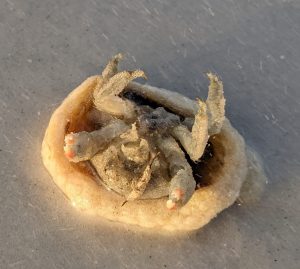
There must be a universal impulse in the animal kingdom to decorate. From prehistoric cave paintings to the countless home remodeling shows on TV, there is something timeless about transforming the place you live into a reflection of your personal character and interests.
For over 700 species of crabs worldwide—many living along our beaches—decoration is more than just aesthetics, but a method of survival. Like the hermit crab in the children’s book, “A House for Hermit Crab,” decorator crabs use other living organisms in their surroundings to camouflage themselves from predators.
If you have ever been hunting or gone out in the field with a serious birder, you are familiar with the extremes people can take to hide from their prey. My favorites are the ghillie suits, the full-face and body swamp thing-type covers used around here by turkey hunters. Turkeys have legendarily sensitive sight, so a single movement can tip them off to a hunter’s presence.

Many marine organisms like octopus and squid are renowned for their chromatophore-driven camouflage, and the bright coloration and disruptive patterns of many reef fish serve them well when trying to hide in plain sight. While these animals possess natural camouflage to hide from their prey (or their predators), the decorator crab is more human-like in its behavior. With no special color or body patterns, the crab consciously creates its own camouflage by plucking items from its surroundings and attaching them to its shell. Examples of “decor” on a given crab range from seaweed and grasses to slow-moving or sessile barnacles, anemones, sponges, or tunicates. The decorator crab in these photos was photographed on Navarre Beach, and is most likely a “hairy sponge crab” (Moreiradromia antillensis) common to the Gulf of Mexico.

Interestingly, the sponge decorator crabs use their claws to carve up sponges and tunicates, then utilize hind legs that point upwards to hold them on their backs (carapace). The tunicate or sponge then serves as a portable shelter and cover, customized to the individual crab and even growing with it.
Decorator crabs predominantly use this camouflage to protect themselves from predators. When motionless, they simply look like a section of coral reef, a bed of algae, a nonmoving sponge, or a mass of anemone. Like most crabs, decorator crabs molt, and when they do, all their previous decor sloughs off with the shell. If there is a particularly useful item on the old shell, they crab may pull it off and reuse on their new shell.
Decorator crabs have special Velcro-like setae on their claws, which make grabbing and moving these decorative/protective organisms easier and faster. Often a symbiotic, mutualistic relationship forms among the crab and the critters on its carapace. As the crab feeds, crumbs from its leftover meals serve as food for the smaller filter feeders. In addition, species like anemones may possess stinging cells that provide an additional level of protection for the crabs from would-be predators.
 1
1
